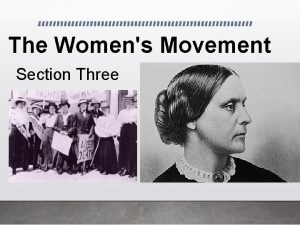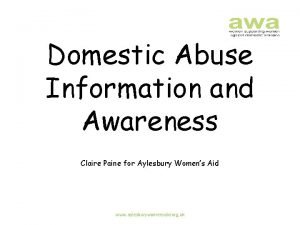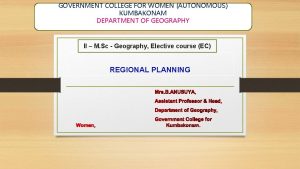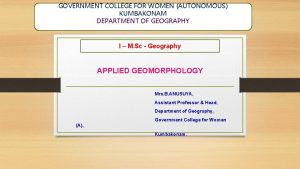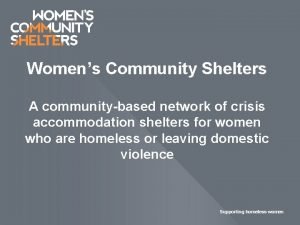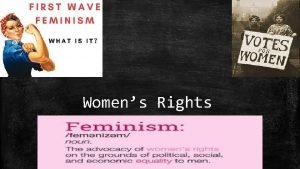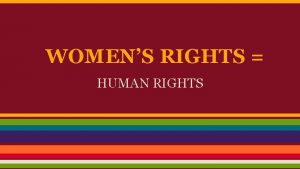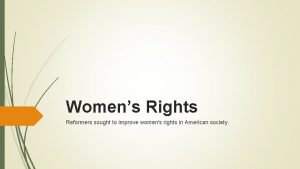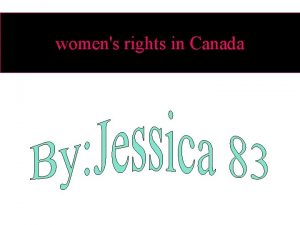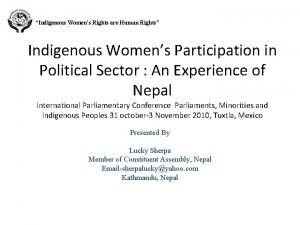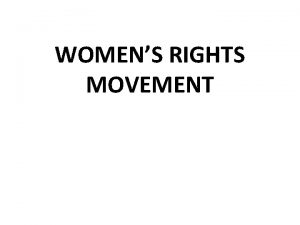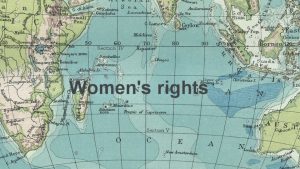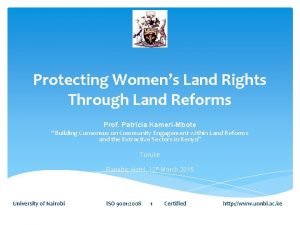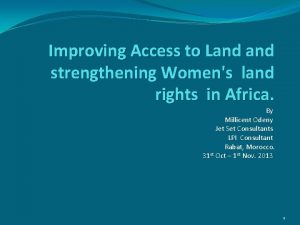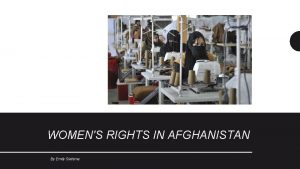WOMENS LAND RIGHTS IN THE POST 2015 DEVELOPMENT

















- Slides: 17

WOMEN’S LAND RIGHTS IN THE POST 2015 DEVELOPMENT AGENDA: RATIONALE, METHODOLOGY, DISSEMINATION INDICATOR 5. A. 2 The Food and Agriculture Organization of the UN (FAO) Gender team, Rome, Italy June 2016

Gender in the VGGT Gender equality in the VGGT “Gender equality: Ensure the equal right of women and men to the enjoyment of all human rights, while acknowledging differences between women and taking specific measures aimed at accelerating de facto equality when necessary. States should ensure that women and girls have equal tenure rights and access to land, fisheries and forests independent of their civil and marital status. " Source: Voluntary Guidelines on the Responsible Governance of Tenure, Land, Fisheries and Forests in the Context of National Food Security, Principle 4)

The Legal Assessment Tool (LAT) for gender-equitable land tenure

The Legal Assessment Tool Theoretical foundation Ø International standards (legally and nonlegally binding): ü Developed in multilateral negotiations ü Have already built international consensus Ø Good practices: to fill in the gaps, more specific 8 Clusters of Key Elements (for a total of 30 Indicators) 1. Ratification of human rights instruments 2. Elimination of gender-based discrimination in the Constitution 3. Recognition of women’s legal capacity 4. Gender-equality of rights with respect to nationality 5. Gender equality in property rights 6. Gender equality in inheritance 7. Gender-equitable implementation, dispute mechanisms and access to justice 8. Women’s participation and leadership in national and local institutions enforcing land legislation

The Legal Assessment Tool LAT methodology Rationale Stage Absence of the indicator in the legal framework 0 A policy is being developed 1 A policy has been adopted 1. 5 A draft legislation is to be submitted for deliberations 2 The indicator is integrated in primary law 3 The indicator appears in multiple legal instruments 4 Not applicable N/A

The Post 2015 Development Agenda Background 17 Sustainable Development Goals proposed by the UN General Assembly Interagency and Expert Group on SDGs (UN agencies + 28 member states) SDG 1: No poverty SDG 2: Zero hunger SDG 3: Good health and well-being SDG 4: Quality education SDG 5: Gender equality SDG 6: Clean water and sanitation SDG 7: Affordable and clean energy SDG 8: Decent work and economic growth SDG 9: Industry, innovation, infrastructure SDG 10: Reduced inequalities SDG 11: Sustainable cities and communities SDG 12: Responsible consumption, production SDG 13: Climate action SDG 14: Life below water SDG 15: Life on land SDG 16: Peace, justice and strong institutions SDG 17: Partnerships for the goals Final list of SDG indicators: http: //unstats. un. org/unsd/statcom/47 th -session/documents/2016 -2 -IAEG-SDGs-E -Revised. pdf

The Post 2015 Development Agenda Achieve gender equality and empower all women and girls Target 5. a “undertake reforms to give women equal rights to economic resources, as well as access to ownership and control over land other forms of property, financial services, inheritance and natural resources, in accordance with national laws” Indicator 5. a. 1 Indicator 5. a. 2 “(a) Percentage of people with ownership or secure rights over agricultural land (out of total agricultural population), by sex; and “Proportion of countries where the legal framework (including customary law) guarantees women’s equal rights to land ownership and/or control”. (b) Share of women among owners or rightsbearers of agricultural land, by type of tenure”

Indicator 5. a. 2 “Proportion of countries where the legal framework (including customary law) guarantees women’s equal rights to land ownership and/or control”. • Not a binary indicator, designed to measure progress towards gender equality • “Land ownership”: legally recognised right to acquire, to use and to transfer landed property. • “Control over land”: ability to make decisions over landed property. • Collects all existing national policy objectives, draft provisions, legal provisions and implementing legislation that reflect good practices in guaranteeing women’s equal rights to land ownership and/or control.

Indicator 5. a. 2 Four proxies under Indicator 5. a. 2 • Proxies = Good practices in strengthening women’s rights to land ownership and/or control. • Intended to capture a range of different regional contexts to reflect the universal scope of the Sustainable Development Goals. They track: ü Government budgetary commitments to strengthening women’s equal rights to land ownership and/or control ü Equality in decision-making over landed property ü Joint titling ü Recording of men and women’s rights in customary tenure systems

Indicator 5. a. 2 • Indicator is already being generated as part of the FAO Legal Assessment Tool Data available for 27 countries • FAO continues to work with countries and partners to scale up the availability of this indicator using a country driven approach. • Recent examples include the Western Balkans initiative, supported by GIZ. • Results are disseminated through the Gender and Land Rights Database

http: //www. fao. org/gender-landrights-database/legislationassessment-tool/indicators/en/? sta_id=964

Reporting under Target 5. a Methodology for country reporting under Indicator 5. a. 2 FAO, as custodian agency for 5. a. 2 developed a methodology for reporting: 1. Designation of Responsible Entity (Mo. J, Human Rights Commissions) 2. Designation of National Legal Expert 3. Expert analysis of the policy and legal framework (questionnaire) 4. Validation of the results by RE 5. Communication of the results to FAO

Reporting under Target 5. a

Reporting under Target 5. a Role of FAO ü Provides support to countries under Indicator 5. a. 2. ü Collects and computes the results and identifies the stage of incorporation using LAT q Stage 0: Absence of all proxies in the legal framework q Stage 1: A draft policy document provides for the adoption of one or more proxy q Stage 1. 5: A formally adopted policy document provides for the adoption of one or more proxy q Stage 2: A bill contains one or more proxy q Stage 3: Primary law contains one or more proxy q Stage 4: Secondary legislation contains one or more proxy ü Communicates the results to SDG secretariat

Reporting under Target 5. a “Proportion of countries where the legal framework (including customary law) guarantees women’s equal rights to land ownership and/or control. ” At the Global Level, progress on the indicator should be reported by stage of incorporation: incorporation v% countries at stage 0 (ie. , absence of all proxies) v% countries at stage 1 (ie. , a policy document provides …) v% countries at stage 2 (ie. , a bill contains at least one proxy… ) v% countries at stage 3 (ie. , At least one proxy exists in the legal framework) v% countries at stage 4 (ie. , At least one proxy exists in several legal instruments

Indicator 5. a. 2 Expected outcomes of Indicator 5. a. 2 ü Increased availability of legal instruments on property rights ü Good practices = special measures: Policy and legal reform is encouraged ü Support to the implementation of the VGGTs ü Increased visibility of country-level processes relating to gender equality in property rights

The Gender and Land Rights Database Thank you! Naomi Kenney Naomi. Kenney@fao. org http: //www. fao. org/gender-landrights-database/legislation-assessment-tool/en/
 Womens rights
Womens rights Womens rights
Womens rights Copyright 2015 all rights reserved
Copyright 2015 all rights reserved Copyright © 2015 all rights reserved
Copyright © 2015 all rights reserved Needs of adolescence
Needs of adolescence Late night womens hour
Late night womens hour Aylesbury womens aid
Aylesbury womens aid Womens right
Womens right Differences between men's and women's soccer
Differences between men's and women's soccer Womens college kumbakonam
Womens college kumbakonam Womens college kumbakonam
Womens college kumbakonam Womens right
Womens right Womens shelter edmonton
Womens shelter edmonton Fornix of vagina
Fornix of vagina Womens history month door
Womens history month door Womens community shelters
Womens community shelters Ballybeen womens centre
Ballybeen womens centre Scarborough womens centre
Scarborough womens centre
